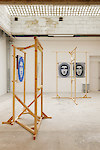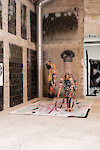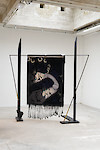




















Jean-Marie Appriou, Ines Doujak, Than Hussein Clark , Thomas Jeppe, Anna Solal
The word decorative has two meanings, either generally embellishing, or more exactly ornamental.
Even though we can consider major part of art history as decorative, speaking nowadays about decorative in relation to fine art, often means a pejorative judgment in regard to some way of cheap attractiveness without complexity, taste and content.
Certain unspoken preconditions constructed in 20th century on which contemporary art still stands, share striking similarities with the roots of modern science. Art asks for the ever proclaimed independence, from market, public and politics, and the consideration of quality that is supposed to be only based on the expert view of its own ever-expanding field. This formerly liberating conditions progressively constituted an entire ideology of art, that rather than reflecting and stimulating art research, precedes it, shapes it and justifies it. In the very same manner as is the notion of the neutral form so closely linked to conceptual art, or the purity of form that serves as the firm ground for all reductive strategies since the early abstraction, this two as many other ideologies controls how art looks and is being judged and perceived.
What connects all those ideologies as a rooting axiom is nonetheless not the idea of art as rational logical activity, although it is one of the most important ones. As even its negations such as the “irrational” art brut can only exist in relation to the rationally build art history lineage, similarly to all the other binary oppositions, the inexhaustible source of rapidly accelerating movement between... [lire plus]
Curator : Michal Novotný